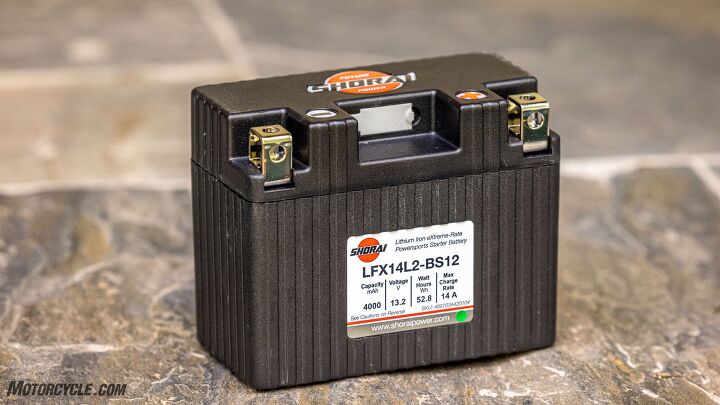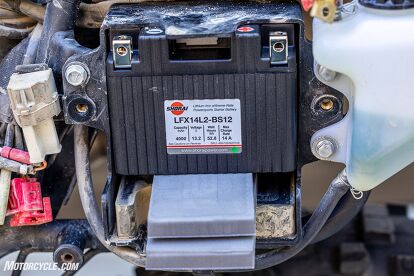MO Tested: Shorai LFX Lithium Battery Review

Longer storage without draining in a smaller, lighter package
Motorcycle batteries are one of the many consumable parts of a motorcycle that we don’t usually think about until we hear the dreaded click-click instead of the starter motor turning over. Sometimes, all that is needed is a recharge to get the battery operational. However, each time a battery gets completely drained, it’s life is shortened. This is particularly common with motorcycles that are only ridden occasionally (like the Kawasaki KLX300 used here). Since lead-acid batteries lose their charge significantly faster than the newer lithium-iron phosphate batteries, I decided it was time to upgrade the stock battery on my Kawasaki KLX300. My battery of choice was the Shorai LFX since the poor KLX sometimes sits for as much as a month – or more – during the oppressive summer heat here in the Southwest.
The Benefits of Shorai LFX Lithium-Iron Phosphate Batteries
Shorai LFX Battery
Smaller and lighter than the OEM lead-acid battery, the Shorai LFX lithium-iron phosphate exhibits less discharge in storage, which is ideal for a bike that only gets ridden intermittently.
Highs
- Light and small
- Handles long-term storage
- Maintains voltage to power bike even when quite depleted
Sighs
- More expensive than lead-acid battery
- Must overcome the prejudice caused by early generation lithium battery problems from fly-by-night vendors
Before you use your Shorai LFX battery, you’ll want to charge it since lithium batteries are shipped only partially charged. Although chargers designed for lithium batteries are better, you can use one that is designed for lead-acid batteries if Shorai’s conditions are met:
“If using a lead acid style charger, do NOT use if it has an automatic ‘desulfation mode”, ‘repair’, ‘recondition’, or ‘recovery’ mode, which cannot be turned off. Lead acid charger/tenders can be used for regular maintenance charging and then be disconnected after the battery is fully charged.”
Installing the Shorai LFX (or any battery) is just about the easiest maintenance task you can perform on a motorcycle. Unless, the sadistic designers hid the battery box under yards of featureless fairing bodywork, the battery can usually be found behind a side panel or under the seat. In the case of the KLX, three bolts were all I needed to remove a side panel and gain access. The next step is to remove the negative wire from the terminal to render the battery safe. If you don’t do this, you can generate some pretty impressive sparks and heat if you accidentally ground the positive pole of the battery to the frame.
Once the wires were disconnected, the two bolts holding the strap securing the battery needed to go. The LFX is significantly smaller than the OEM lead-acid one, so I needed to size the included foam padding and stick it to the battery box to keep the diminutive Shorai from rattling around. After that, I bolted on the strap and reconnected the cables, attaching the positive terminal first. After remounting the body work, I faced the biggest challenge of the whole process – figuring out the correct button-push combination to reset the clock.
The first turn of the ignition switch revealed that I was running a lithium-iron battery. The voltmeter no longer reads in the 12V range. Instead, it displays 13.3V when fully charged. Now, I don’t need to worry about the quicker rate of discharge associated with the OEM lead acid battery, and although it’s not really important on the KLX300, I saved 3.2 lb. Because of the slightly higher voltage, my engine cranks over more quickly and starts faster.
The problem with reviewing batteries is that since I’ve only been using this Shorai LFX for a short time, I can’t tell you how long it is going to last. Unfortunately, if I waited to let you know how long the battery lasted before it failed, battery technology would likely have marched ahead rendering the review useless. My experience with my three previous forays into lithium-iron phosphate batteries from major manufacturers (of which the lengthiest use was a Shorai) is that all but one lasted considerably longer than lead-acid batteries on bikes that were used infrequently and kept on a smart charger. The lithium batteries are still cranking away (or, in the case of the Shorai, was when I sold the bike two years ago) without incident. The only lithium battery failure was in a race battery that lacked the battery monitoring system (BMS) to protect it from discharging completely and rendering it useless. (You can guess what I accidentally did.) Shorai batteries all contain BMS circuitry, which helps balance discharging and recharging loads, preventing the battery from overheating. The BMS also prevents the LFX from discharging to a point where it would not be able to recharge.
If you find yourself in need of a new battery for your motorcycle, the Shorai LFX should serve you well both in terms of saving weight and holding a charge in storage, making the extra cost a worthwhile investment.
FAQ
Are lithium batteries ok for motorcycles?
All modern motorcycles – provided their charging systems are in good working order – are capable of utilizing lithium batteries. As discussed in this article, lithium batteries offer several advantages over conventional lead-acid batteries: smaller size, lighter weight, less loss of power in storage, and more consistent delivery of voltage regardless of charge status.
Do you need a special charger for lithium batteries?
Lithium batteries can safely be charged with smart chargers designed for lead-acid batteries, as long as the charger does not have a desulfation mode. Additionally, the lead-acid charger should be disconnected from the lithium battery after it is fully charged. If long-term use of a charger is planned, using one designed for lithium batteries will deliver the best results.
Can you overcharge lithium batteries?
Quality lithium batteries contain a battery monitoring system (BMS) that should protect the lithium packs from damage from both overcharging and over depletion. However, as with all electronics, large spikes of voltage can damage a BMS.
Related Reading
The Benefits of Shorai LFX Lithium-Iron Phosphate Batteries
Lithium Motorcycle Batteries: Myths VS Realities - Updated
MO Tested: Shorai LFX Lithium-Iron Battery Update
We are committed to finding, researching, and recommending the best products. We earn commissions from purchases you make using the retail links in our product reviews. Learn more about how this works.
Become a Motorcycle.com insider. Get the latest motorcycle news first by subscribing to our newsletter here.

Like most of the best happenings in his life, Evans stumbled into his motojournalism career. While on his way to a planned life in academia, he applied for a job at a motorcycle magazine, thinking he’d get the opportunity to write some freelance articles. Instead, he was offered a full-time job in which he discovered he could actually get paid to ride other people’s motorcycles – and he’s never looked back. Over the 25 years he’s been in the motorcycle industry, Evans has written two books, 101 Sportbike Performance Projects and How to Modify Your Metric Cruiser, and has ridden just about every production motorcycle manufactured. Evans has a deep love of motorcycles and believes they are a force for good in the world.
More by Evans Brasfield








































Comments
Join the conversation
This was my experience with a Shorai 8 years ago. I would definitely buy another one.
https://ridermagazine.com/2015/05/08/blog-shorai-lithium-iron-battery-follow-up-review/
My OEM factory fitted lead acid battery quit in its 9th year, I replaced it with the same. Why spend more money on a high tech lithium battery when there is no added gain.